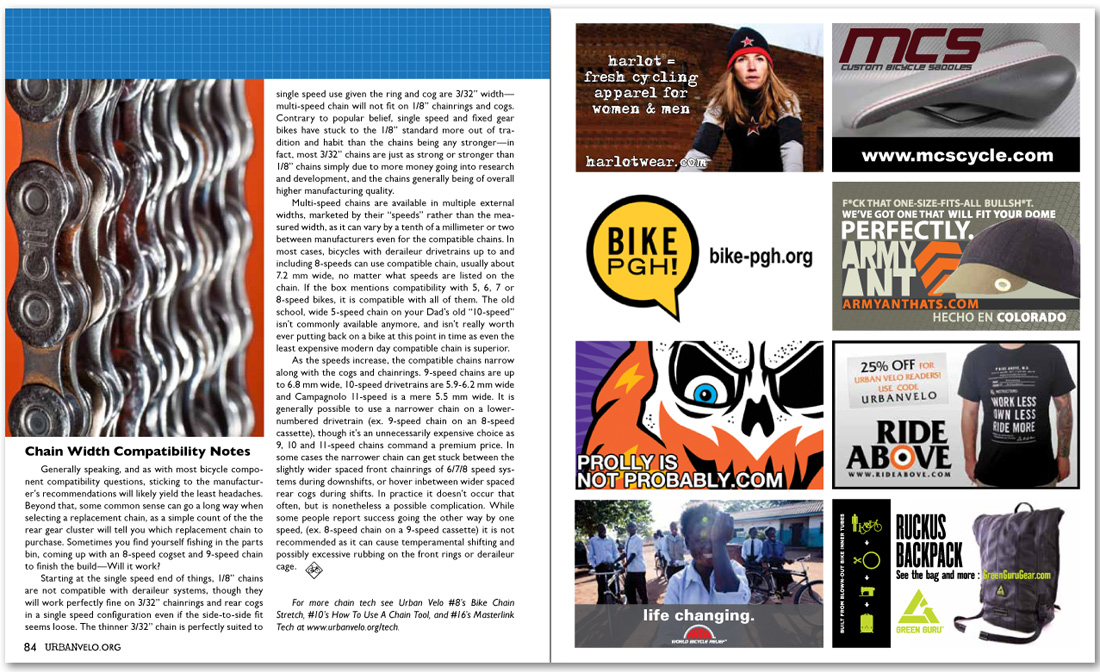


Chain Width Compatibility Notes
Generally speaking, and as with most bicycle component compatibility questions, sticking to the manufacturer’s recommendations will likely yield the least headaches. Beyond that, some common sense can go a long way when selecting a replacement chain, as a simple count of the the rear gear cluster will tell you which replacement chain to purchase. Sometimes you find yourself fishing in the parts bin, coming up with an 8-speed cogset and 9-speed chain to finish the build—Will it work?
Starting at the single speed end of things, 1/8” chains are not compatible with deraileur systems, though they will work perfectly fine on 3/32” chainrings and rear cogs in a single speed configuration even if the side-to-side fit seems loose. The thinner 3/32” chain is perfectly suited to single speed use given the ring and cog are 3/32” width—multi-speed chain will not fit on 1/8” chainrings and cogs. Contrary to popular belief, single speed and fixed gear bikes have stuck to the 1/8” standard more out of tradition and habit than the chains being any stronger—in fact, most 3/32” chains are just as strong or stronger than 1/8” chains simply due to more money going into research and development, and the chains generally being of overall higher manufacturing quality.
Multi-speed chains are available in multiple external widths, marketed by their “speeds” rather than the measured width, as it can vary by a tenth of a millimeter or two between manufacturers even for the compatible chains. In most cases, bicycles with deraileur drivetrains up to and including 8-speeds can use compatible chain, usually about 7.2 mm wide, no matter what speeds are listed on the chain. If the box mentions compatibility with 5, 6, 7 or 8-speed bikes, it is compatible with all of them. The old school, wide 5-speed chain on your Dad’s old “10-speed” isn’t commonly available anymore, and isn’t really worth ever putting back on a bike at this point in time as even the least expensive modern day compatible chain is superior.
As the speeds increase, the compatible chains narrow along with the cogs and chainrings. 9-speed chains are up to 6.8 mm wide, 10-speed drivetrains are 5.9-6.2 mm wide and Campagnolo 11-speed is a mere 5.5 mm wide. It is generally possible to use a narrower chain on a lower-numbered drivetrain (ex. 9-speed chain on an 8-speed cassette), though it’s an unnecessarily expensive choice as 9, 10 and 11-speed chains command a premium price. In some cases the narrower chain can get stuck between the slightly wider spaced front chainrings of 6/7/8 speed systems during downshifts, or hover inbetween wider spaced rear cogs during shifts. In practice it doesn’t occur that often, but is nonetheless a possible complication. While some people report success going the other way by one speed, (ex. 8-speed chain on a 9-speed cassette) it is not recommended as it can cause temperamental shifting and possibly excessive rubbing on the front rings or deraileur cage.
For more chain tech see Urban Velo #8’s Bike Chain Stretch, #10’s How To Use A Chain Tool, and #16’s Masterlink Tech at www.urbanvelo.org/tech.